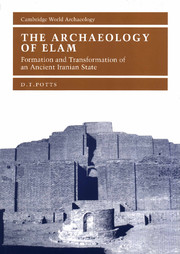Book contents
- Frontmatter
- Contents
- List of illustrations
- List of plates
- List of tables
- Preface and acknowledgements
- List of abbreviations
- Note on transliteration and dating systems
- 1 Elam: what, when, where?
- 2 Environment, climate and resources
- 3 The immediate precursors of Elam
- 4 Elam and Awan
- 5 The dynasty of Shimashki
- 6 The grand regents of Elam and Susa
- 7 The kingdom of Susa and Anshan
- 8 The Neo-Elamite period
- 9 Elam in the Achaemenid empire
- 10 Elymais
- 11 Elam under the Sasanians and beyond
- 12 Conclusion
- References
- Index
10 - Elymais
Published online by Cambridge University Press: 22 September 2009
- Frontmatter
- Contents
- List of illustrations
- List of plates
- List of tables
- Preface and acknowledgements
- List of abbreviations
- Note on transliteration and dating systems
- 1 Elam: what, when, where?
- 2 Environment, climate and resources
- 3 The immediate precursors of Elam
- 4 Elam and Awan
- 5 The dynasty of Shimashki
- 6 The grand regents of Elam and Susa
- 7 The kingdom of Susa and Anshan
- 8 The Neo-Elamite period
- 9 Elam in the Achaemenid empire
- 10 Elymais
- 11 Elam under the Sasanians and beyond
- 12 Conclusion
- References
- Index
Summary
The survival of the Elamites as a distinct ethno-linguistic group is well-attested in the period following Alexander the Great's conquest of Western Asia. In Khuzistan we find continued occupation at major sites like Susa in the last centuries BC and first centuries AD, along with the foundation of important new sites like Masjid-i Solaiman, Tang-i Sarvak and Bard-e Nechandeh. Greek and Latin sources from the period speak of Elymais and the Elymaeans, in whom we can recognize without difficulty latter day Elamites. To a large extent the Elymaeans resisted the imposition of foreign rule by the successors of Alexander the Great, the Seleucid emperors (so named after the founder of the dynasty, Seleucus I). The geography of Elymaean territory was described by Strabo and attacks against them were made by several Seleucids, notably Antiochus III and IV.
With the demise of the Seleucid empire in the east, the major state in Iran was that of the Parthians. Originating in what is today the Khorassan province of northeastern Iran and adjacent portions of Turkmenistan, the Parthians appeared on the historical scene late in the third century BC when their first king, Arsaces I (c. 238–211 BC), began minting coins in his capital Nisa, near modern Ashgabat in Turkmenistan. By about 140 BC, the Parthian king Mithridates I had probably taken possession of Susa and was threatening Babylonia.
- Type
- Chapter
- Information
- The Archaeology of ElamFormation and Transformation of an Ancient Iranian State, pp. 354 - 409Publisher: Cambridge University PressPrint publication year: 1999



